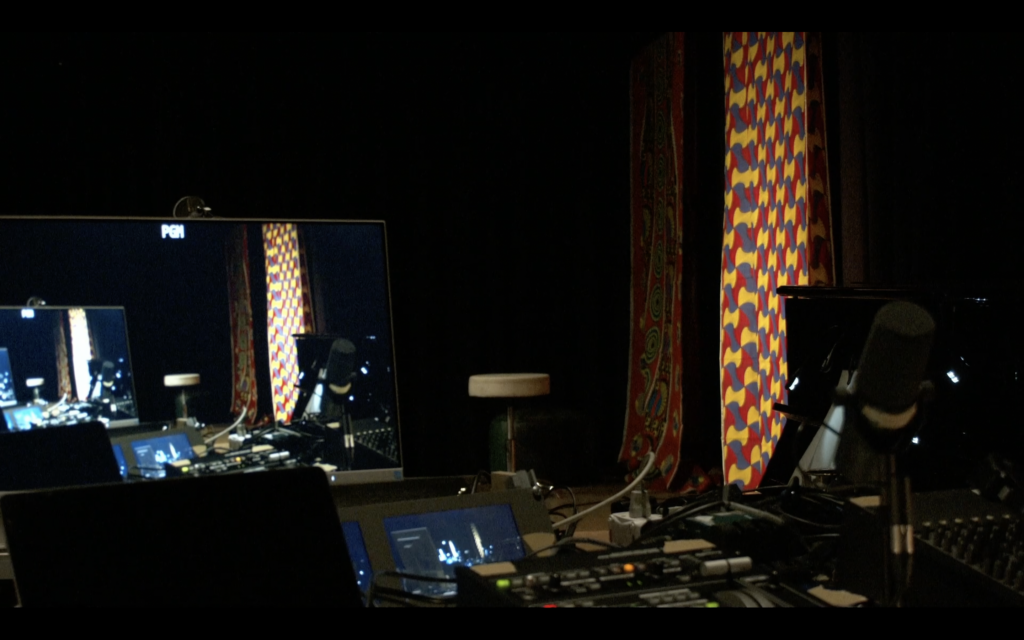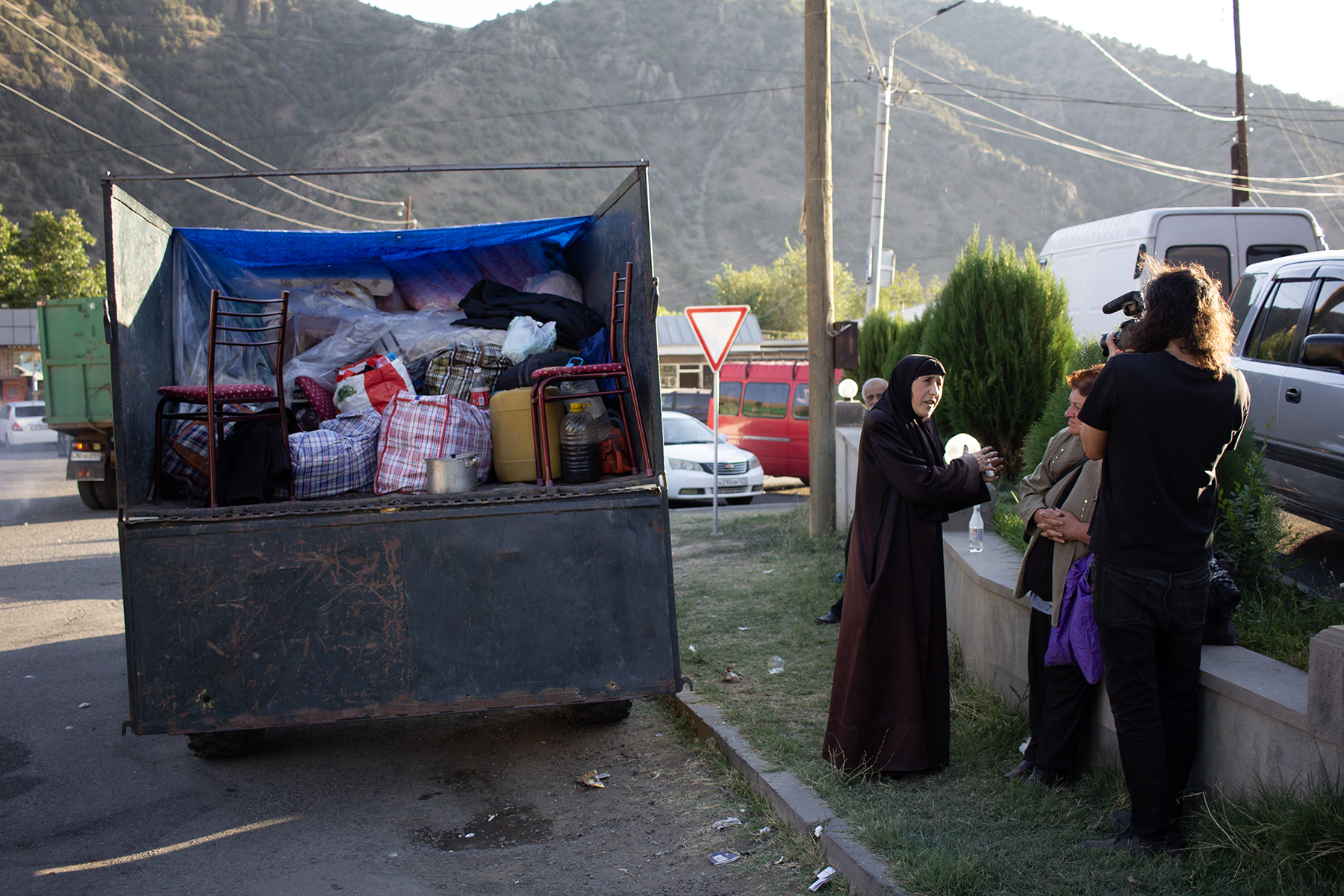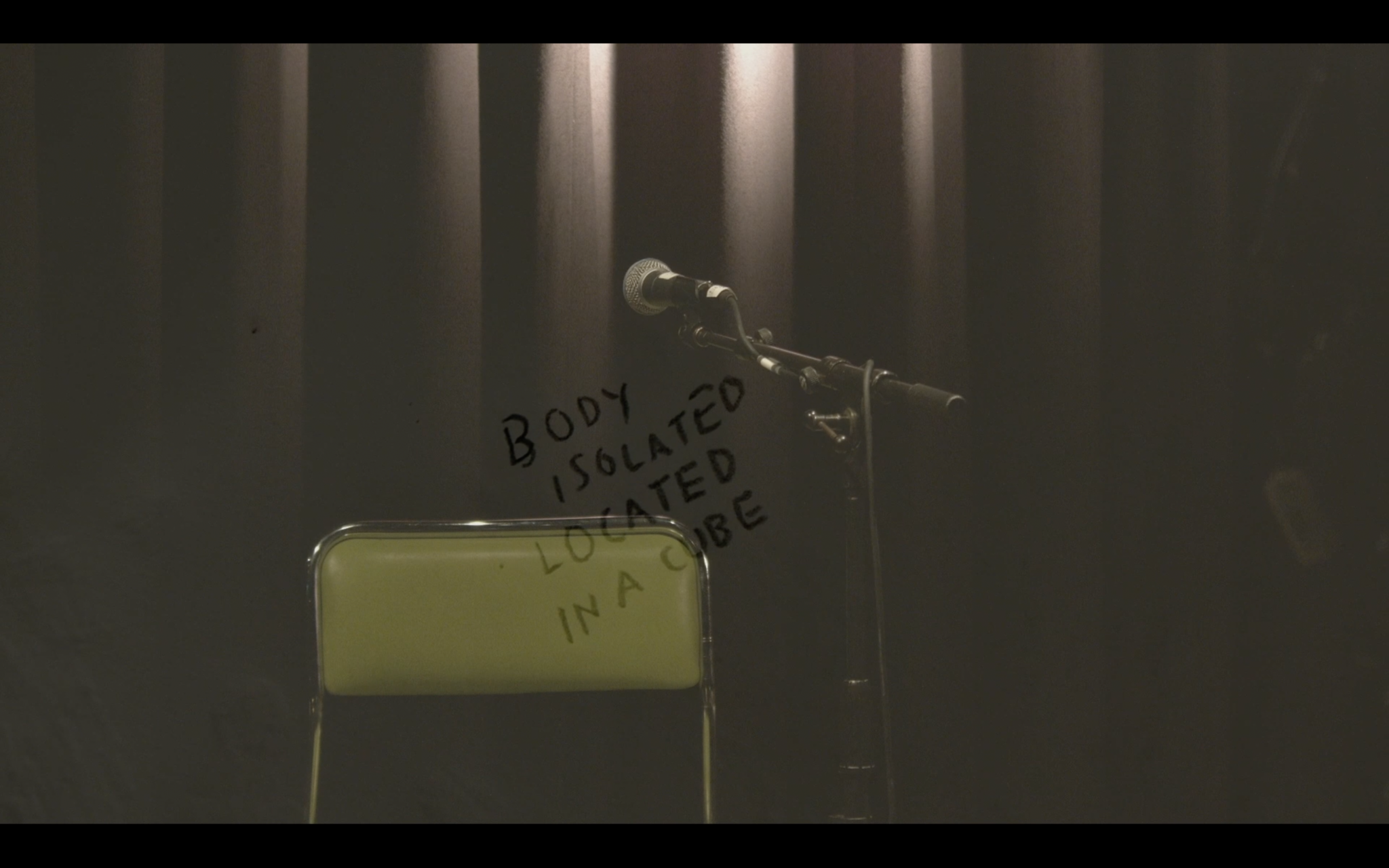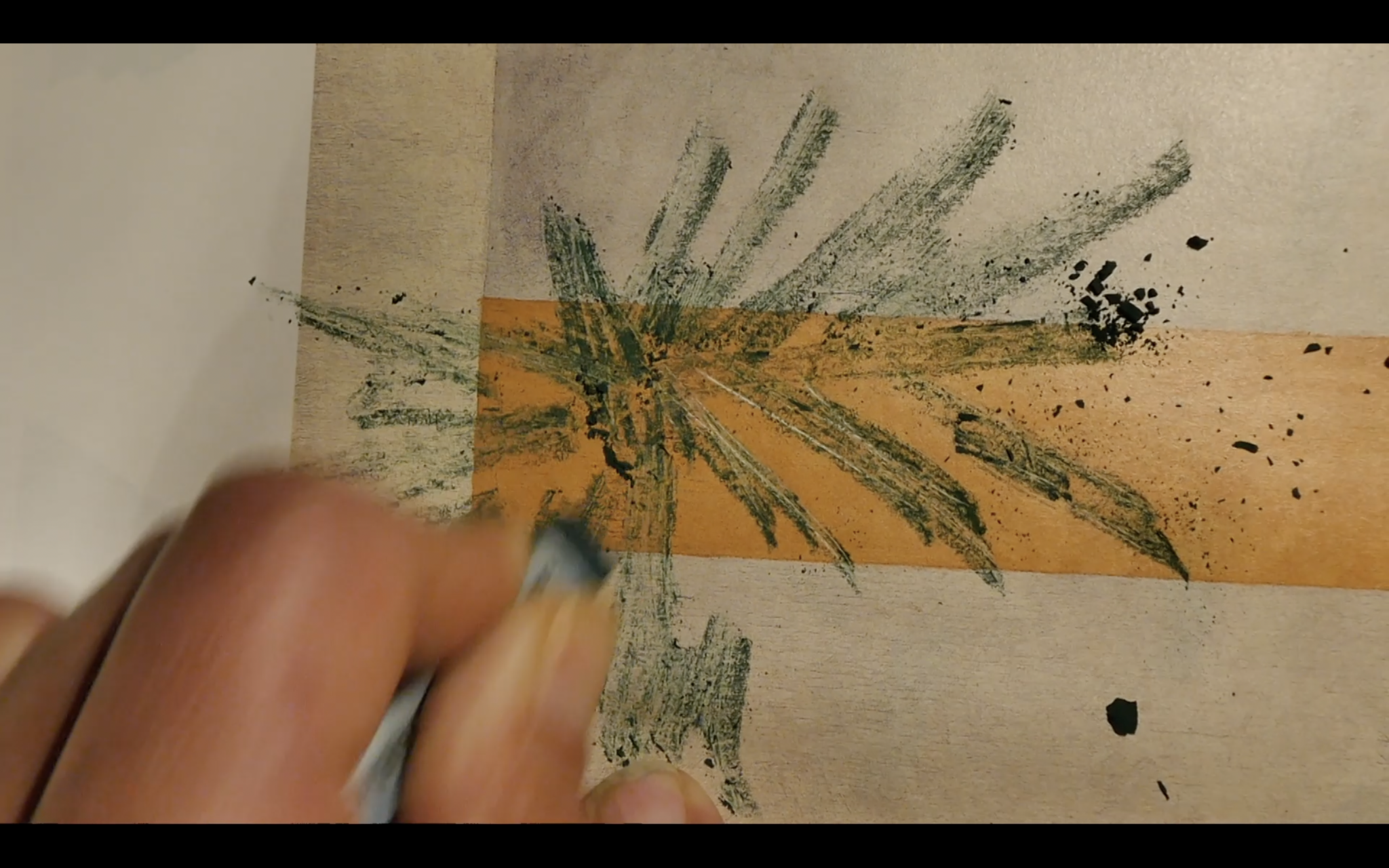For Ever Gaza
For Ever Gaza
A few bodies enter a room with the collective equipment for making a film. Some other bodies enter a hall to view it. It is the opening night of a series of encounters which may resemble a collective journey, even a seance, attempting to conjure and animate senses, images, sounds, utterances, gestures, thoughts, feelings of, from, with worlds which have and will survive the death of the monolith world of colonial, racial, patriarchal, capitalist modernity. The film to be screened has not yet been seen by its makers nor those who have invited it. It will be seen for the first time on the occasion of its making, as an unfolding, unworking of a form and its dis/contents.
This form of opening or inauguration embodies the radical ethics of this journey or ‘seance:’ to open it with the unforeseen and the unknown.
If the film is to have an orientation, one could say it’s a film about our times, our worlds at the brink, on the edge, at a cross-roads, in front of a crisis, in its original sense in the Greek word krisis, that is, a decisive moment, in which the decision will determine whether something lives or dies.
A. To stand on the side of life, by seeing the resistance to genocide in Palestine as a turning point to overcome, abolish, decolonize, destitute, delink from the denialist institutions, infrastructures which insist on preserving their cultures of supremacy and salvaging the world which destroys worlds.
B. To stand on the side of death, allow this genocide to continue, remain silent, equivocate, unsee, comply, by collaborating with all the institutions, especially those within culture, who toil today to create just enough smoke and distraction to forget it, normalize it, prolong it, deny it, securing a future for fascist colonial supremacist violence, not only against Palestinians and by extension all racialized, dehumanized peoples, but also against earth itself.
Ayreen and Rene make the most philosophically rich, politically rigorous, experimentally generous live film-performances we know of: they are neither quite performance or documentary, essay or fiction. Their events at Episode 1: A Film is a Statement in 2012, and in our programme at the 2012 Whitney Biennial, felt like watching Jean-Luc Nancy make live annotations on your favourite Straub–Huillet film, in the midst of everyday life, cooking, abolitionist demos and labour disputes.
Join Ayreen and Rene in conversation with others at their Towards Nakba as a Planetary Process assembly on Sunday 17th November.
For Ever Gaza, For Ever Palestine
1. It’s a film that is unmaking film. It is an experience of divestment from a modality of film which has never stopped being a party to the Nakba, if not in content then in its forms.
2. It’s a film that refuses to deny the Nakba and the ongoing genocide in Palestine, in Gaza.
3. It’s a film that does not try to make sense of the Nakba as much as it attempts to establish a time-space of accessing the scale of it, in its capacity to unmake us and our sense of an us.
4. It’s a film that allows the form of film to be affected, to revoke itself, to get rid of its selves, its sovereignties, its colonial dresses, its modern attires, its forms of lie, its formal lies,
5. Its unmaking is a process of demarcating the sides. The sides which justify and try to prolong the ongoing catastrophe, the Nakba in all its planetary dimensions, reverberations, precedents and consequents. And the sides which attempt to search for the paths of exit, try to put an end to it, to outlive it, to survive it.
6. It refuses to accept a conception and a destiny for art and film, as an accessory and instrument of denialism.
7. It’s a film which refuses to partake in the arts of whiteboxing* which capture, delimit, control, channel, and enlist our world making capacities toward ignoring, enjoying, mutilating, normalizing the incessant destruction of worlds.
8. A film which refuses art as a factory of producing band aids, sedatives, relaxants, anesthetics, as in, an aesthetics of forgetfulness, of oblivion, of indolence, of structured, wilful and often celebrated ignorance. It is an ongoing practice of revoking the finer arts of window dressing, covering up or over, hiding of the gaping wounds from the genocidal violence – that has never stopped to be justified – against our communities, and today, in Palestine and most intensively in Gaza, shows its vicious, brutal, self-righteous and denialist core.
9. What is a film or art that is not only present to this violence, but tries in its unmaking, to shake off all the residues of a cinema soaked, sanctified, elevated in denial.
10. Is such an art and film possible?
11. If the dominant notions of art have been used mainly as a kind of alibi, the soft arm and the displaced justification of the long durée of ongoing carnage, the civilizational front and cultural backbone of genocidal-denialist futurity; can those who have been the victims, the targets, the harmed, the wretched of earth, can we reclaim those means?
12. What if art, poetry, dance, music, film in their hegemonic forms are themselves parts of the toolset of the masters?
13. It is a film that tries to wrestle away the destiny of cinema and by association all art from the practitioners of denial and the facilitators of genocide.
14. It is a film thus that tries to exit the imperial, colonial understanding, sense, practice of art and film. It is and has been a parting from a practice that disavows the time of its making, the presence of the bodies in a place which assemble to sense, to feel, to understand, undergo something together.
15. It is a film that wrestles with and against the apparatus and dispositif of the cinema and the tools it conjured to produce, represent and fabricate a unitary world that has hitherto not been stopped in its destruction of worlds.
16. It’s a cinema of our time, our time together, in the moment that we gather, to look. But what do we see? And what do we unsee as we see? What are we looking at and what are we looking for when we go to the cinema, when we go to see that thing? What kind of thing can we share in which we can undo, unmake our ways of seeing?
17. “They see with blind eyes?” Who said that? Was it about me or you, who were we before and who will we be after these atrocities whose disseminated images form an integral part of the perpetrators’ pornography of brutality and its continued, structured forms of denial?
18. What kind of film can endure the monstrousness not only of the perpetration of genocide in Gaza and throughout Palestine since 1948, 1917 and before, but also be the very means of confronting the membranes and structures of denial, sewn into the forms of Western art making, art viewing, which facilitate its continuation.
19. Can such a film take place? Can cinema still call forth bodies to receive and perceive a film which unsettles the racial, colonial, supremacist, police, sovereign, patriarchal, Cartesian eye and I?
20. It’s a film that refuses to absence the dead. It is a film which refuses to go along with the show.
21. It’s a film which allows the unfolding and ongoing catastrophe to spill into it, disrupting its seemlessness, in fact, it is its own disrupting, it is a disruption, or irruption of the unknown and unforeseen.
22. It is a film that is continually risks being unmade in its making. Disclosing while refusing to be closed up, patched up or patching up the wounds. It is a process and practice of opening what has been closed and foreclosed as possibility for film and art. That is, its disenclosure. It is in that sense not only a practice or idea of anti-colonial and anti-capitalist cinema, but also an abolitionist one, breaking film and art out of its incarcerated state.
23. If it is to be called a film of improvisation, then the understanding of this term would have to be the opposite of a film that has been pre-visioned, pre-scripted, pre-screened, subjected to the eye of the judges, the censors within and without, the determiners of good and bad, of taste, of civility, of culture, of control, of high and low, of management, of certification, of prediction, of planning, of channelling, of awarding and owning, of accounting and commanding, of authoring and governing if not ruling over the seen and unseen, of value and of the senses.
24. If it is a film against the artist, as author, as sovereign subject imbued with decision and will, then, it is also a film against the spectator as the purveyor and collector of experiences of oblivion and denial, of likes and dislikes, of routine, fascist pleasures.
25. Rather than spectatorship then, this film calls forth an assembling of bodies who will give time to bring something as yet unseen, unheard into life. By its very form it seeks to retire the judges which have been cultivated in so many of us, policing thought, taste, perception, who are what can enter; who are what can be seen, who are what matters.
26. It also tries to resituate cinema and art as radically anti-denialist spaces, resolutely breaking from any form of normalizing of the calls from above to order, conjoining feelings with thought with action with struggle, occasioning situations of organizing our senses of our lives and our worlds in common.
27. It is a film as a communal experience of watching something unseen come into the field of vision and thus an experiment of our capacity to make something visible that was not seen before; and then on the part of those who witness, to gauge whether they were indeed able to perceive it, to see with and through it, to the other side, to the side which has always been assigned and relegated to low the lower class, race, gender, to barbarity, as uncivilized and thus endlessly brutalized.
28. It is a film against genocide and the denial which fuels it. But more than that, it is a film that recognizes that cinema and more broadly art have and continue to be, one of the dominant instruments if not weapons of acculturation and production of a futurity premised on ongoing mass violence and programmed denial.
29. It’s not a film about an unfolding genocide in Palestine, as much as it is a film that tries to wrestle with a form, a medium, as fiction, as documentary, as celluloid, as video, as media, as illusion has and continues to be a weapon for producing that genocide.
30. It is a cinema refusing separations including the isolation of Palestine from its planetary consequences and resonances.
31. It’s a film as a question and a search.
32. It’s a film that is unsettled and unsettling.
33. It’s a film that will not stop, that will not rest, cannot be completed, cannot end, it remains on the run, because it has to live, even outlive, a future, which has until now, been nothing but genocidal and denialist.
Bios
Ayreen Anastas, a body in search of gestures, words, phrases, sentences to disactivate and destitute the impositions, forms, including the form of biography this form of self, to bring about some forces which give potency to life to bodies with and around them. How to not separate one ‘self?’ from a common that helps shape life and gives it intensity and meaning. How to become unintelligible, incomprehensible, opaque to the fabricated machines of subjectivation and self-making. How to write in a language that only friends-to-come receive, a language that wrestles with language to keep the relations to all the palestines and to their forms of life alive.
Rene Gabri is another name for that process of recovering stolen life. The name is not gendered, though it has engendered enough confusion to assign to it all sorts of pronouns and prescriptions. It is a non-native name calling forth a native life, a life constantly pushed to the margins of oblivion. It recalls sites of previous and ongoing battles. It remains steadfastly associated with the wind, which is the closest kin or resembling a homeland. In this searching, a question which re-emerges: is wind origin, destiny or the unforeseen push toward a dissemination of the seeds of whatever could become recovery.

▴ Credit: Image courtesy of Rene Gabri and Ayreen Anastas

▴ Credit: Image courtesy of Rene Gabri and Ayreen Anastas

▴ Credit: Image courtesy of Rene Gabri and Ayreen Anastas

▴ Credit: Image courtesy of Rene Gabri and Ayreen Anastas

▴ Credit: Image courtesy of Rene Gabri and Ayreen Anastas

▴ Credit: Image courtesy of Rene Gabri and Ayreen Anastas
Access
Live Captions
Live Stream
See general Access information for Episode 11: To End the World As We Know It event
Artists

Ayreen Anastas







